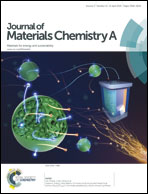Control of the mesoporous structure of dye-sensitized solar cells with electrospray deposition
Abstract
To meet nanofabrication requirements, such as control of structure and scalability, we investigated an electrospray-based method to manufacture photoanodes for Dye-Sensitized Solar Cells (DSSCs). Charged droplets are generated, carrying TiO2 nanoparticles, and deposited using an electric field. We show how morphology, structure and performance of resulting films can be controlled by varying: (a) nanoparticle loading in the slurry and, consequently, the size of the nanoparticle clusters, (b) droplet evaporation rate before impact on the substrate and, consequently, contact of the clusters, and (c) film density. We demonstrate examples in which the film structure affects device performance. Generally, electrosprayed DSSCs have higher open-circuit voltage and fill factor as compared to standards based on spincoating, whereas the latter exhibit higher short-circuit current density. Electrochemical impedance spectroscopy helped rationalize these findings in terms of larger recombination resistance and lower chemical capacitance of the electrosprayed cells. Performance merits of the two approaches can be combined synergistically into a bilayer structure of highest efficiency, with densely packed spincoated particles at the bottom of the deposit, where light absorption is critical, and a more loosely packed electrosprayed layer on top, which is advantageous for hole transport in the electrolyte and as a back-scattering layer.


 Please wait while we load your content...
Please wait while we load your content...